Introduction to Business Studies: Motivation and Finance Report
VerifiedAdded on 2023/01/12
|11
|2782
|71
Report
AI Summary
This report provides an in-depth analysis of business studies, focusing on two key areas: employee motivation and financial management. The report begins by exploring various motivation techniques, including Maslow's Hierarchy of Needs and McClelland's Theory of Motivation, evaluating their advantages and limitations, and applying them to the context of Jack Stores. The second part of the report shifts to financial management, examining both short-term and long-term sources of finance available to a company, Zylla Company, and discussing investment appraisal techniques, such as the payback period and net present value (NPV), in relation to the acquisition of a ferry. The report offers a comprehensive overview of these crucial business concepts, providing practical insights and examples to enhance understanding.
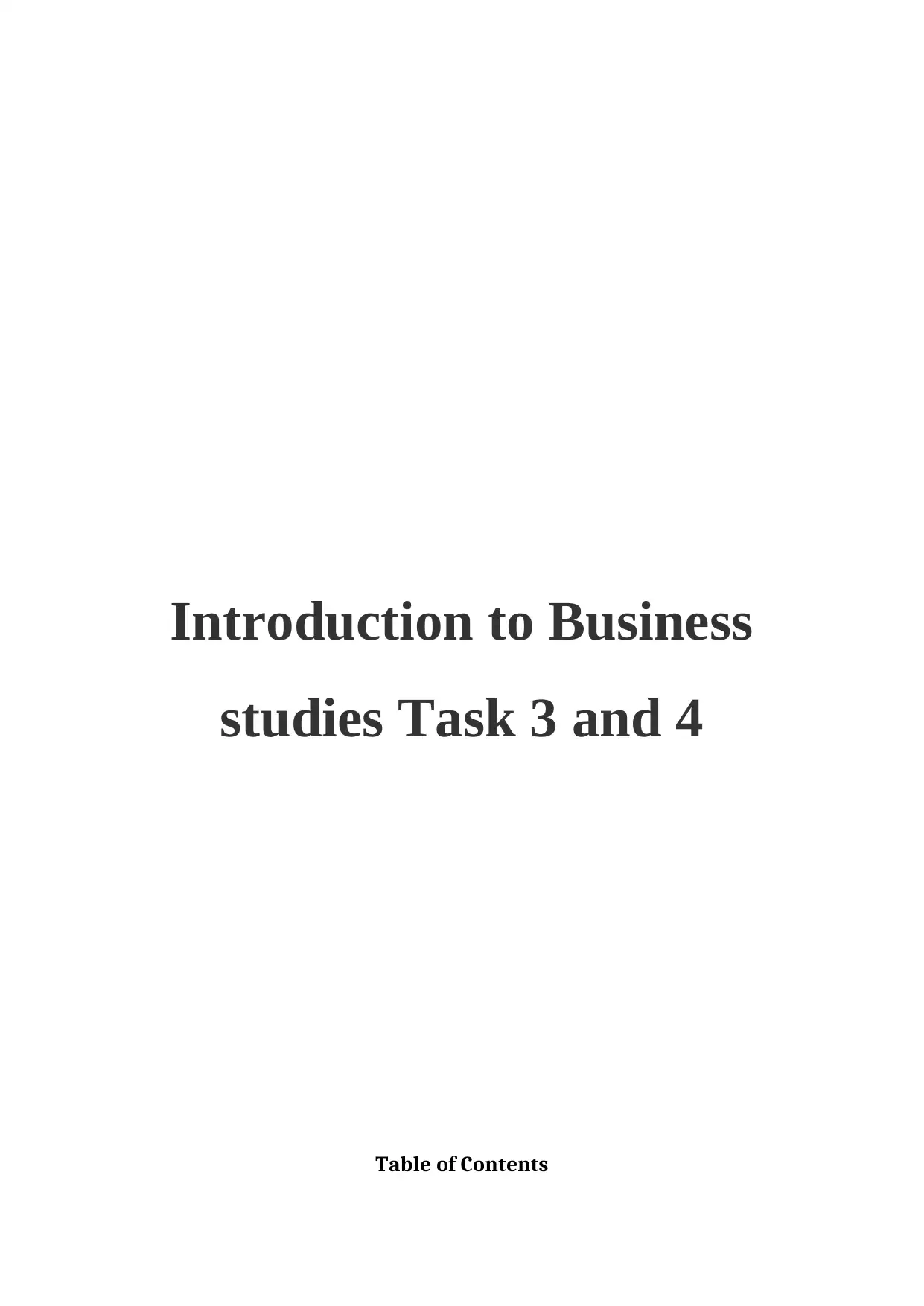
Introduction to Business
studies Task 3 and 4
Table of Contents
studies Task 3 and 4
Table of Contents
Paraphrase This Document
Need a fresh take? Get an instant paraphrase of this document with our AI Paraphraser

INTRODUCTION.................................................................................................................................3
Task 3....................................................................................................................................................3
Motivation Techniques......................................................................................................................3
CONCLUSION.....................................................................................................................................6
Task 4....................................................................................................................................................6
1. Short term and long term sources of finance..............................................................................6
2. Investment appraisal techniques....................................................................................................8
CONCLUSION...................................................................................................................................10
REFERENCES....................................................................................................................................11
Task 3....................................................................................................................................................3
Motivation Techniques......................................................................................................................3
CONCLUSION.....................................................................................................................................6
Task 4....................................................................................................................................................6
1. Short term and long term sources of finance..............................................................................6
2. Investment appraisal techniques....................................................................................................8
CONCLUSION...................................................................................................................................10
REFERENCES....................................................................................................................................11
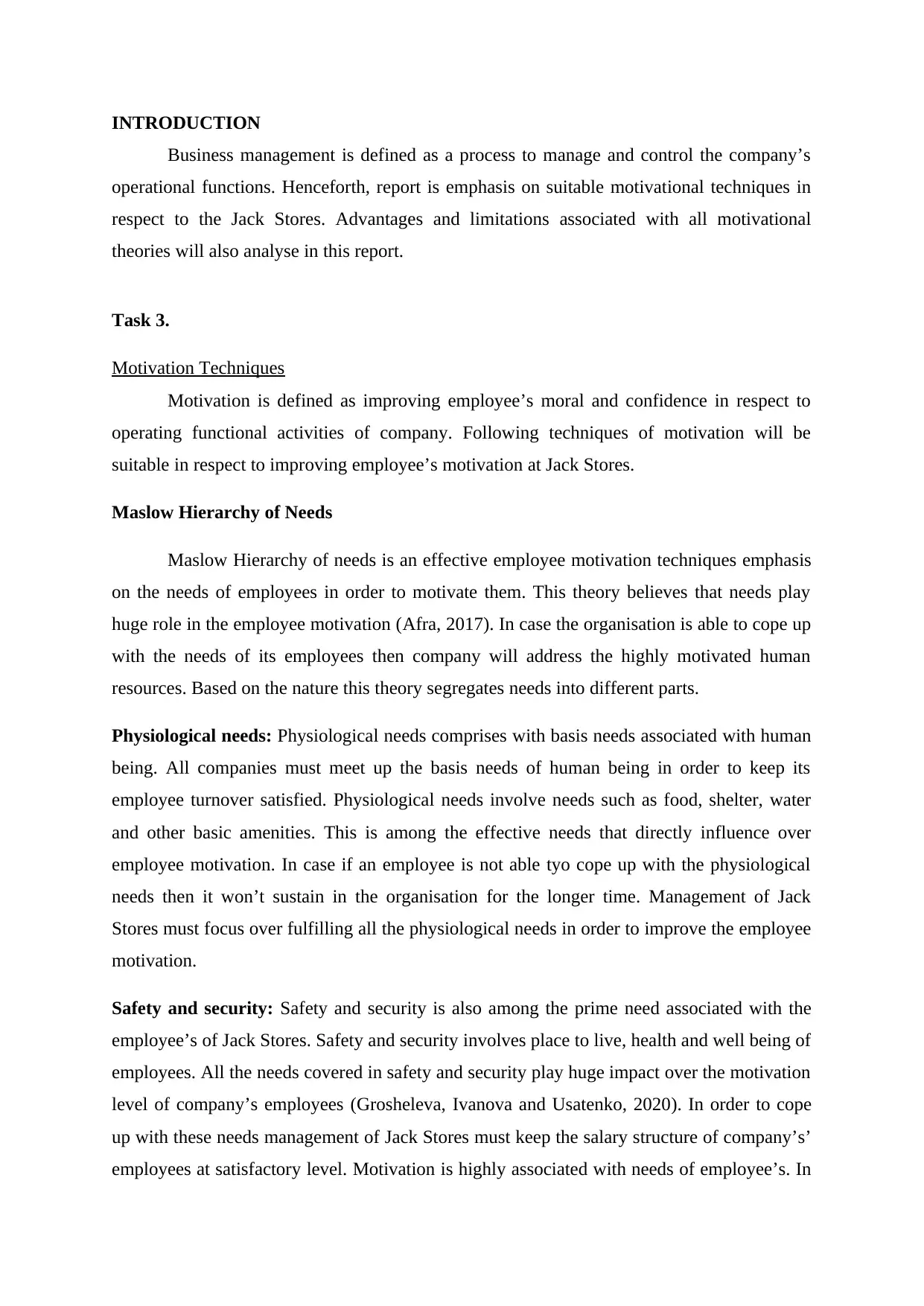
INTRODUCTION
Business management is defined as a process to manage and control the company’s
operational functions. Henceforth, report is emphasis on suitable motivational techniques in
respect to the Jack Stores. Advantages and limitations associated with all motivational
theories will also analyse in this report.
Task 3.
Motivation Techniques
Motivation is defined as improving employee’s moral and confidence in respect to
operating functional activities of company. Following techniques of motivation will be
suitable in respect to improving employee’s motivation at Jack Stores.
Maslow Hierarchy of Needs
Maslow Hierarchy of needs is an effective employee motivation techniques emphasis
on the needs of employees in order to motivate them. This theory believes that needs play
huge role in the employee motivation (Afra, 2017). In case the organisation is able to cope up
with the needs of its employees then company will address the highly motivated human
resources. Based on the nature this theory segregates needs into different parts.
Physiological needs: Physiological needs comprises with basis needs associated with human
being. All companies must meet up the basis needs of human being in order to keep its
employee turnover satisfied. Physiological needs involve needs such as food, shelter, water
and other basic amenities. This is among the effective needs that directly influence over
employee motivation. In case if an employee is not able tyo cope up with the physiological
needs then it won’t sustain in the organisation for the longer time. Management of Jack
Stores must focus over fulfilling all the physiological needs in order to improve the employee
motivation.
Safety and security: Safety and security is also among the prime need associated with the
employee’s of Jack Stores. Safety and security involves place to live, health and well being of
employees. All the needs covered in safety and security play huge impact over the motivation
level of company’s employees (Grosheleva, Ivanova and Usatenko, 2020). In order to cope
up with these needs management of Jack Stores must keep the salary structure of company’s’
employees at satisfactory level. Motivation is highly associated with needs of employee’s. In
Business management is defined as a process to manage and control the company’s
operational functions. Henceforth, report is emphasis on suitable motivational techniques in
respect to the Jack Stores. Advantages and limitations associated with all motivational
theories will also analyse in this report.
Task 3.
Motivation Techniques
Motivation is defined as improving employee’s moral and confidence in respect to
operating functional activities of company. Following techniques of motivation will be
suitable in respect to improving employee’s motivation at Jack Stores.
Maslow Hierarchy of Needs
Maslow Hierarchy of needs is an effective employee motivation techniques emphasis
on the needs of employees in order to motivate them. This theory believes that needs play
huge role in the employee motivation (Afra, 2017). In case the organisation is able to cope up
with the needs of its employees then company will address the highly motivated human
resources. Based on the nature this theory segregates needs into different parts.
Physiological needs: Physiological needs comprises with basis needs associated with human
being. All companies must meet up the basis needs of human being in order to keep its
employee turnover satisfied. Physiological needs involve needs such as food, shelter, water
and other basic amenities. This is among the effective needs that directly influence over
employee motivation. In case if an employee is not able tyo cope up with the physiological
needs then it won’t sustain in the organisation for the longer time. Management of Jack
Stores must focus over fulfilling all the physiological needs in order to improve the employee
motivation.
Safety and security: Safety and security is also among the prime need associated with the
employee’s of Jack Stores. Safety and security involves place to live, health and well being of
employees. All the needs covered in safety and security play huge impact over the motivation
level of company’s employees (Grosheleva, Ivanova and Usatenko, 2020). In order to cope
up with these needs management of Jack Stores must keep the salary structure of company’s’
employees at satisfactory level. Motivation is highly associated with needs of employee’s. In
⊘ This is a preview!⊘
Do you want full access?
Subscribe today to unlock all pages.

Trusted by 1+ million students worldwide
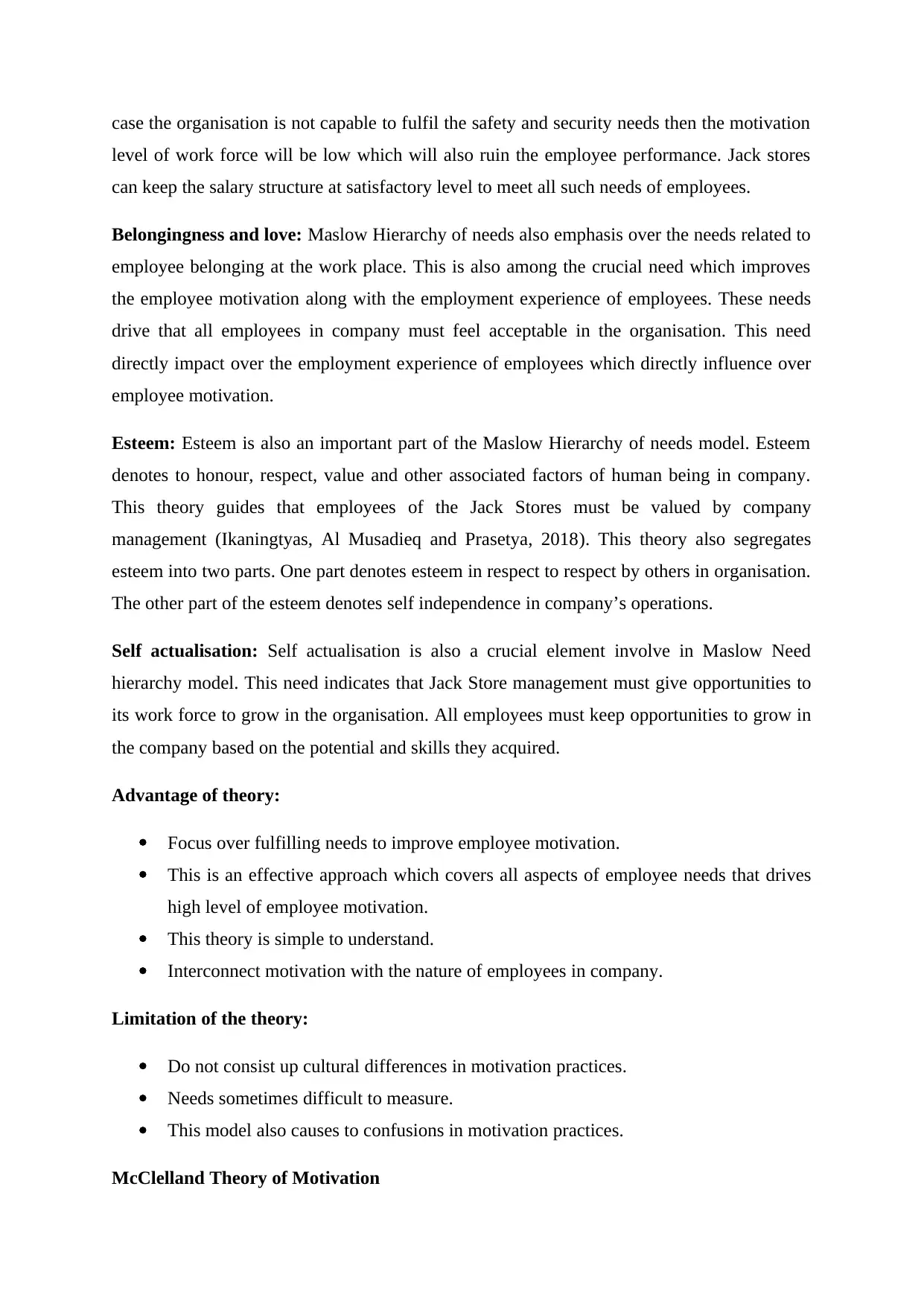
case the organisation is not capable to fulfil the safety and security needs then the motivation
level of work force will be low which will also ruin the employee performance. Jack stores
can keep the salary structure at satisfactory level to meet all such needs of employees.
Belongingness and love: Maslow Hierarchy of needs also emphasis over the needs related to
employee belonging at the work place. This is also among the crucial need which improves
the employee motivation along with the employment experience of employees. These needs
drive that all employees in company must feel acceptable in the organisation. This need
directly impact over the employment experience of employees which directly influence over
employee motivation.
Esteem: Esteem is also an important part of the Maslow Hierarchy of needs model. Esteem
denotes to honour, respect, value and other associated factors of human being in company.
This theory guides that employees of the Jack Stores must be valued by company
management (Ikaningtyas, Al Musadieq and Prasetya, 2018). This theory also segregates
esteem into two parts. One part denotes esteem in respect to respect by others in organisation.
The other part of the esteem denotes self independence in company’s operations.
Self actualisation: Self actualisation is also a crucial element involve in Maslow Need
hierarchy model. This need indicates that Jack Store management must give opportunities to
its work force to grow in the organisation. All employees must keep opportunities to grow in
the company based on the potential and skills they acquired.
Advantage of theory:
Focus over fulfilling needs to improve employee motivation.
This is an effective approach which covers all aspects of employee needs that drives
high level of employee motivation.
This theory is simple to understand.
Interconnect motivation with the nature of employees in company.
Limitation of the theory:
Do not consist up cultural differences in motivation practices.
Needs sometimes difficult to measure.
This model also causes to confusions in motivation practices.
McClelland Theory of Motivation
level of work force will be low which will also ruin the employee performance. Jack stores
can keep the salary structure at satisfactory level to meet all such needs of employees.
Belongingness and love: Maslow Hierarchy of needs also emphasis over the needs related to
employee belonging at the work place. This is also among the crucial need which improves
the employee motivation along with the employment experience of employees. These needs
drive that all employees in company must feel acceptable in the organisation. This need
directly impact over the employment experience of employees which directly influence over
employee motivation.
Esteem: Esteem is also an important part of the Maslow Hierarchy of needs model. Esteem
denotes to honour, respect, value and other associated factors of human being in company.
This theory guides that employees of the Jack Stores must be valued by company
management (Ikaningtyas, Al Musadieq and Prasetya, 2018). This theory also segregates
esteem into two parts. One part denotes esteem in respect to respect by others in organisation.
The other part of the esteem denotes self independence in company’s operations.
Self actualisation: Self actualisation is also a crucial element involve in Maslow Need
hierarchy model. This need indicates that Jack Store management must give opportunities to
its work force to grow in the organisation. All employees must keep opportunities to grow in
the company based on the potential and skills they acquired.
Advantage of theory:
Focus over fulfilling needs to improve employee motivation.
This is an effective approach which covers all aspects of employee needs that drives
high level of employee motivation.
This theory is simple to understand.
Interconnect motivation with the nature of employees in company.
Limitation of the theory:
Do not consist up cultural differences in motivation practices.
Needs sometimes difficult to measure.
This model also causes to confusions in motivation practices.
McClelland Theory of Motivation
Paraphrase This Document
Need a fresh take? Get an instant paraphrase of this document with our AI Paraphraser
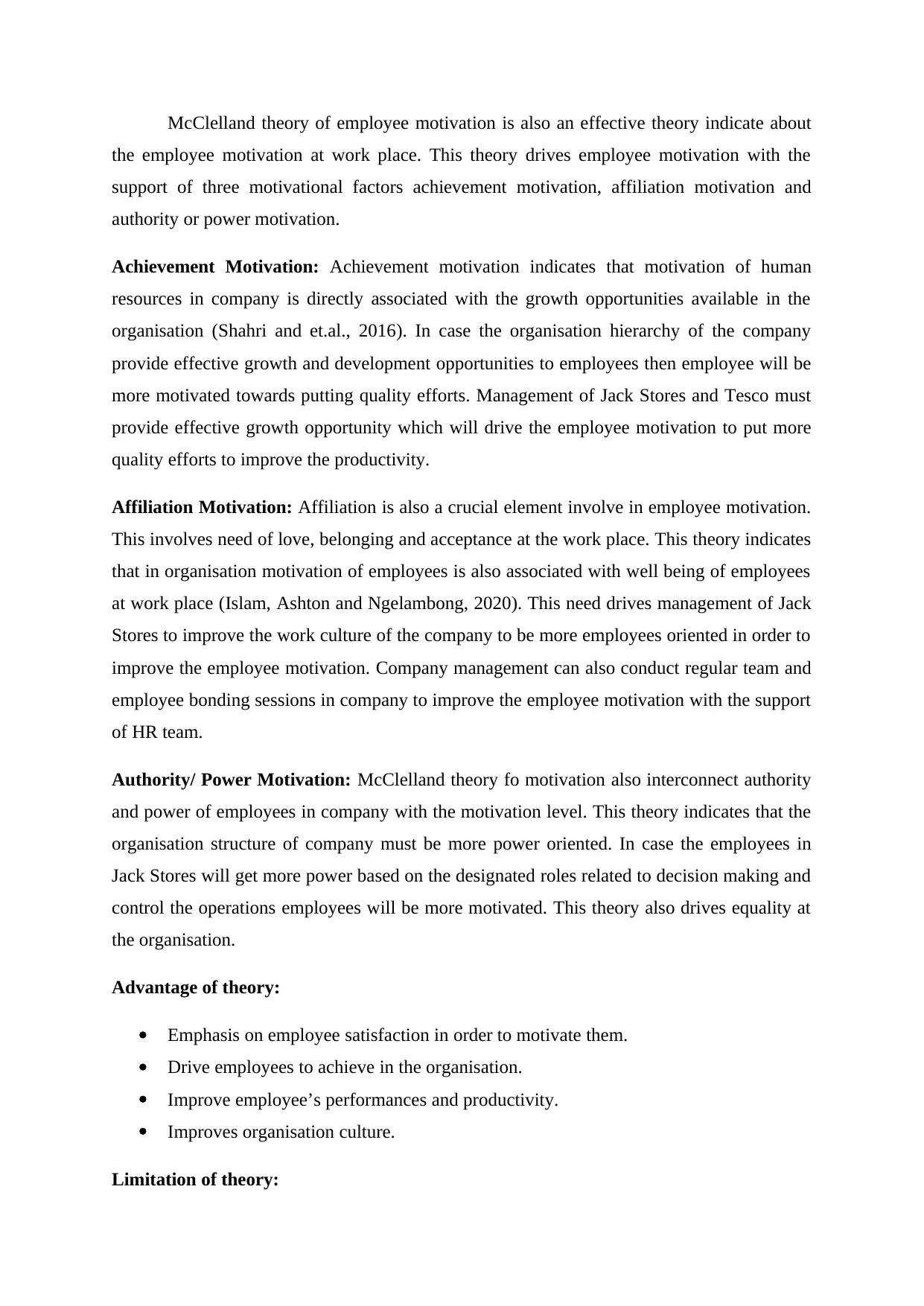
McClelland theory of employee motivation is also an effective theory indicate about
the employee motivation at work place. This theory drives employee motivation with the
support of three motivational factors achievement motivation, affiliation motivation and
authority or power motivation.
Achievement Motivation: Achievement motivation indicates that motivation of human
resources in company is directly associated with the growth opportunities available in the
organisation (Shahri and et.al., 2016). In case the organisation hierarchy of the company
provide effective growth and development opportunities to employees then employee will be
more motivated towards putting quality efforts. Management of Jack Stores and Tesco must
provide effective growth opportunity which will drive the employee motivation to put more
quality efforts to improve the productivity.
Affiliation Motivation: Affiliation is also a crucial element involve in employee motivation.
This involves need of love, belonging and acceptance at the work place. This theory indicates
that in organisation motivation of employees is also associated with well being of employees
at work place (Islam, Ashton and Ngelambong, 2020). This need drives management of Jack
Stores to improve the work culture of the company to be more employees oriented in order to
improve the employee motivation. Company management can also conduct regular team and
employee bonding sessions in company to improve the employee motivation with the support
of HR team.
Authority/ Power Motivation: McClelland theory fo motivation also interconnect authority
and power of employees in company with the motivation level. This theory indicates that the
organisation structure of company must be more power oriented. In case the employees in
Jack Stores will get more power based on the designated roles related to decision making and
control the operations employees will be more motivated. This theory also drives equality at
the organisation.
Advantage of theory:
Emphasis on employee satisfaction in order to motivate them.
Drive employees to achieve in the organisation.
Improve employee’s performances and productivity.
Improves organisation culture.
Limitation of theory:
the employee motivation at work place. This theory drives employee motivation with the
support of three motivational factors achievement motivation, affiliation motivation and
authority or power motivation.
Achievement Motivation: Achievement motivation indicates that motivation of human
resources in company is directly associated with the growth opportunities available in the
organisation (Shahri and et.al., 2016). In case the organisation hierarchy of the company
provide effective growth and development opportunities to employees then employee will be
more motivated towards putting quality efforts. Management of Jack Stores and Tesco must
provide effective growth opportunity which will drive the employee motivation to put more
quality efforts to improve the productivity.
Affiliation Motivation: Affiliation is also a crucial element involve in employee motivation.
This involves need of love, belonging and acceptance at the work place. This theory indicates
that in organisation motivation of employees is also associated with well being of employees
at work place (Islam, Ashton and Ngelambong, 2020). This need drives management of Jack
Stores to improve the work culture of the company to be more employees oriented in order to
improve the employee motivation. Company management can also conduct regular team and
employee bonding sessions in company to improve the employee motivation with the support
of HR team.
Authority/ Power Motivation: McClelland theory fo motivation also interconnect authority
and power of employees in company with the motivation level. This theory indicates that the
organisation structure of company must be more power oriented. In case the employees in
Jack Stores will get more power based on the designated roles related to decision making and
control the operations employees will be more motivated. This theory also drives equality at
the organisation.
Advantage of theory:
Emphasis on employee satisfaction in order to motivate them.
Drive employees to achieve in the organisation.
Improve employee’s performances and productivity.
Improves organisation culture.
Limitation of theory:
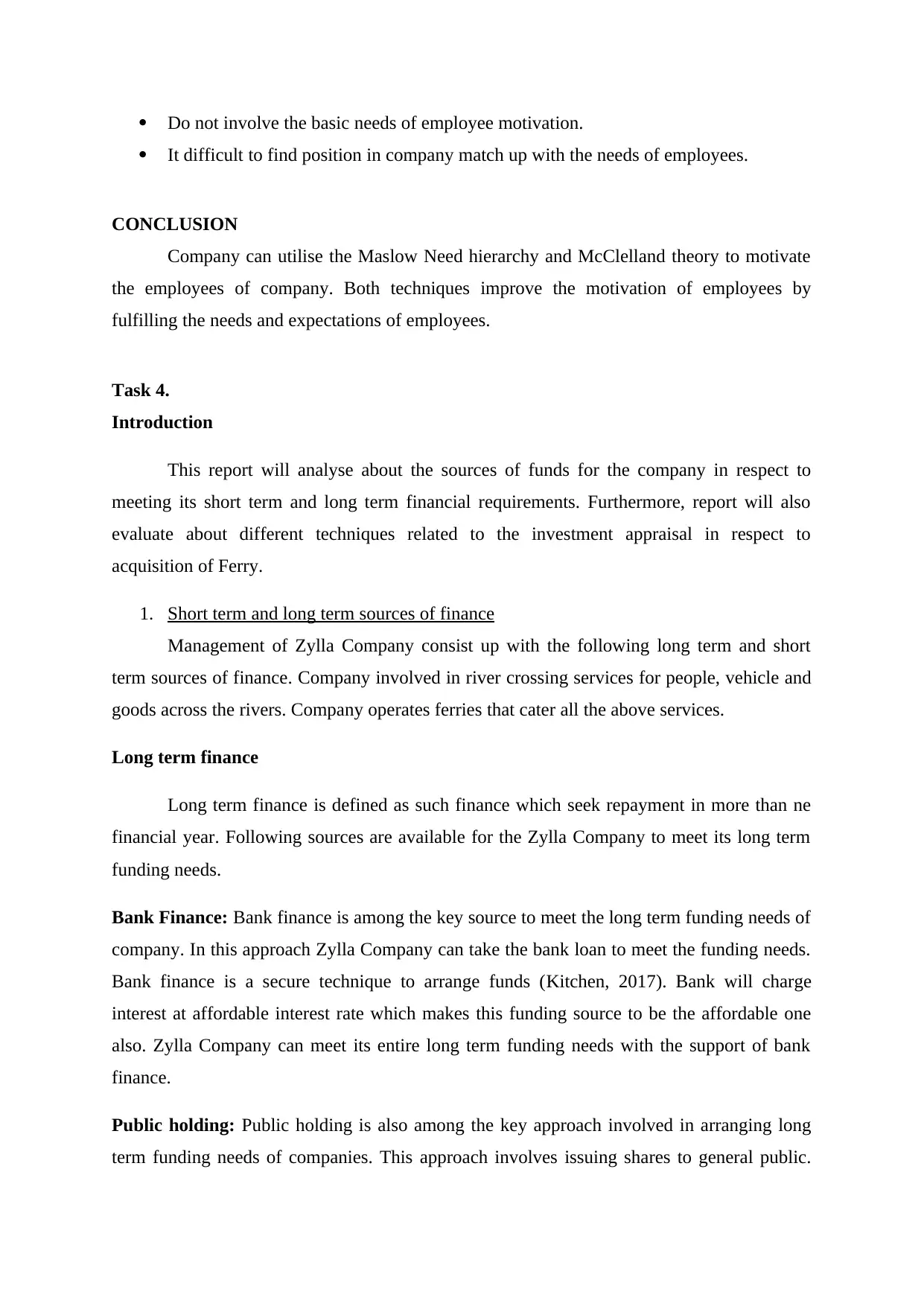
Do not involve the basic needs of employee motivation.
It difficult to find position in company match up with the needs of employees.
CONCLUSION
Company can utilise the Maslow Need hierarchy and McClelland theory to motivate
the employees of company. Both techniques improve the motivation of employees by
fulfilling the needs and expectations of employees.
Task 4.
Introduction
This report will analyse about the sources of funds for the company in respect to
meeting its short term and long term financial requirements. Furthermore, report will also
evaluate about different techniques related to the investment appraisal in respect to
acquisition of Ferry.
1. Short term and long term sources of finance
Management of Zylla Company consist up with the following long term and short
term sources of finance. Company involved in river crossing services for people, vehicle and
goods across the rivers. Company operates ferries that cater all the above services.
Long term finance
Long term finance is defined as such finance which seek repayment in more than ne
financial year. Following sources are available for the Zylla Company to meet its long term
funding needs.
Bank Finance: Bank finance is among the key source to meet the long term funding needs of
company. In this approach Zylla Company can take the bank loan to meet the funding needs.
Bank finance is a secure technique to arrange funds (Kitchen, 2017). Bank will charge
interest at affordable interest rate which makes this funding source to be the affordable one
also. Zylla Company can meet its entire long term funding needs with the support of bank
finance.
Public holding: Public holding is also among the key approach involved in arranging long
term funding needs of companies. This approach involves issuing shares to general public.
It difficult to find position in company match up with the needs of employees.
CONCLUSION
Company can utilise the Maslow Need hierarchy and McClelland theory to motivate
the employees of company. Both techniques improve the motivation of employees by
fulfilling the needs and expectations of employees.
Task 4.
Introduction
This report will analyse about the sources of funds for the company in respect to
meeting its short term and long term financial requirements. Furthermore, report will also
evaluate about different techniques related to the investment appraisal in respect to
acquisition of Ferry.
1. Short term and long term sources of finance
Management of Zylla Company consist up with the following long term and short
term sources of finance. Company involved in river crossing services for people, vehicle and
goods across the rivers. Company operates ferries that cater all the above services.
Long term finance
Long term finance is defined as such finance which seek repayment in more than ne
financial year. Following sources are available for the Zylla Company to meet its long term
funding needs.
Bank Finance: Bank finance is among the key source to meet the long term funding needs of
company. In this approach Zylla Company can take the bank loan to meet the funding needs.
Bank finance is a secure technique to arrange funds (Kitchen, 2017). Bank will charge
interest at affordable interest rate which makes this funding source to be the affordable one
also. Zylla Company can meet its entire long term funding needs with the support of bank
finance.
Public holding: Public holding is also among the key approach involved in arranging long
term funding needs of companies. This approach involves issuing shares to general public.
⊘ This is a preview!⊘
Do you want full access?
Subscribe today to unlock all pages.

Trusted by 1+ million students worldwide
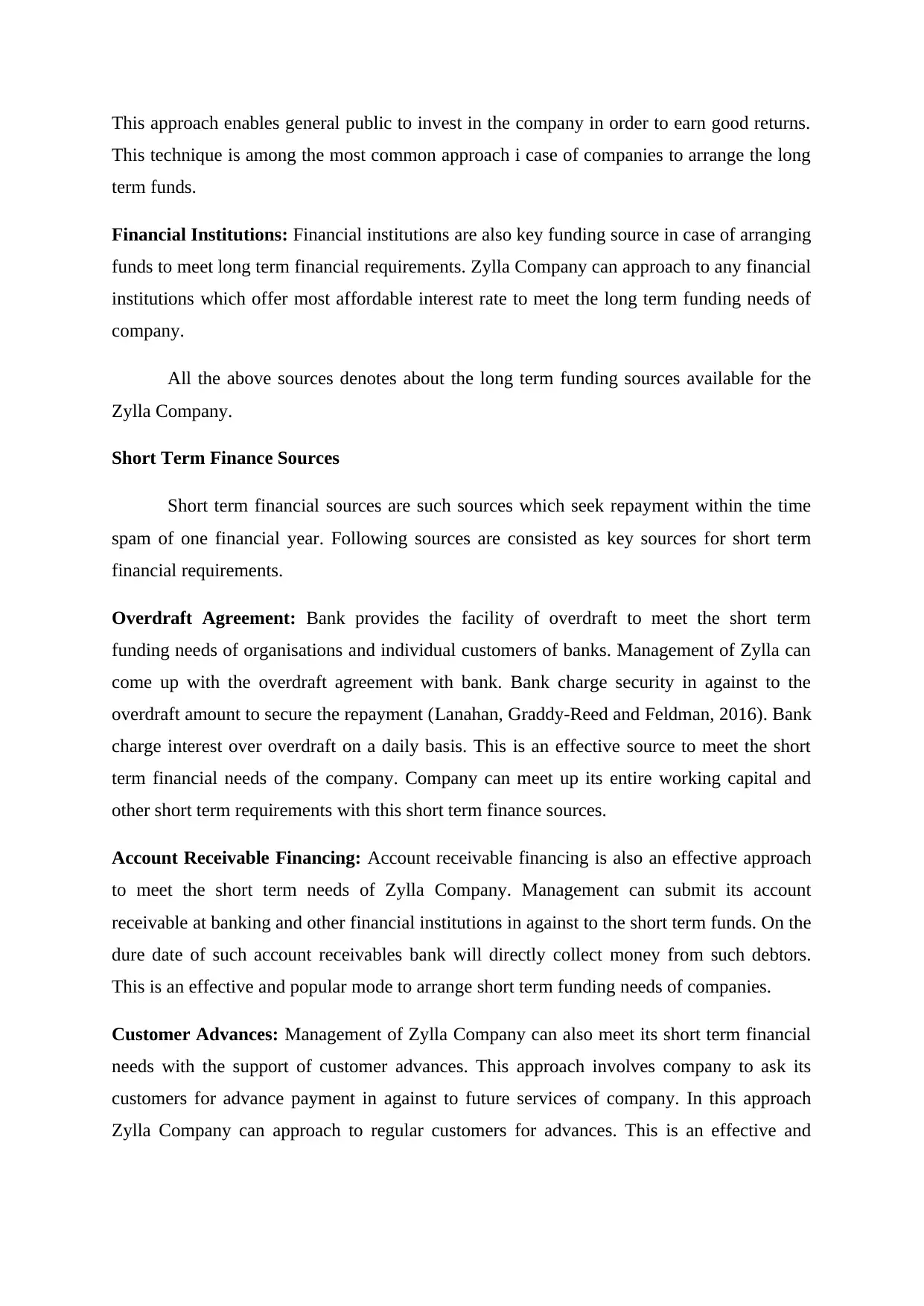
This approach enables general public to invest in the company in order to earn good returns.
This technique is among the most common approach i case of companies to arrange the long
term funds.
Financial Institutions: Financial institutions are also key funding source in case of arranging
funds to meet long term financial requirements. Zylla Company can approach to any financial
institutions which offer most affordable interest rate to meet the long term funding needs of
company.
All the above sources denotes about the long term funding sources available for the
Zylla Company.
Short Term Finance Sources
Short term financial sources are such sources which seek repayment within the time
spam of one financial year. Following sources are consisted as key sources for short term
financial requirements.
Overdraft Agreement: Bank provides the facility of overdraft to meet the short term
funding needs of organisations and individual customers of banks. Management of Zylla can
come up with the overdraft agreement with bank. Bank charge security in against to the
overdraft amount to secure the repayment (Lanahan, Graddy-Reed and Feldman, 2016). Bank
charge interest over overdraft on a daily basis. This is an effective source to meet the short
term financial needs of the company. Company can meet up its entire working capital and
other short term requirements with this short term finance sources.
Account Receivable Financing: Account receivable financing is also an effective approach
to meet the short term needs of Zylla Company. Management can submit its account
receivable at banking and other financial institutions in against to the short term funds. On the
dure date of such account receivables bank will directly collect money from such debtors.
This is an effective and popular mode to arrange short term funding needs of companies.
Customer Advances: Management of Zylla Company can also meet its short term financial
needs with the support of customer advances. This approach involves company to ask its
customers for advance payment in against to future services of company. In this approach
Zylla Company can approach to regular customers for advances. This is an effective and
This technique is among the most common approach i case of companies to arrange the long
term funds.
Financial Institutions: Financial institutions are also key funding source in case of arranging
funds to meet long term financial requirements. Zylla Company can approach to any financial
institutions which offer most affordable interest rate to meet the long term funding needs of
company.
All the above sources denotes about the long term funding sources available for the
Zylla Company.
Short Term Finance Sources
Short term financial sources are such sources which seek repayment within the time
spam of one financial year. Following sources are consisted as key sources for short term
financial requirements.
Overdraft Agreement: Bank provides the facility of overdraft to meet the short term
funding needs of organisations and individual customers of banks. Management of Zylla can
come up with the overdraft agreement with bank. Bank charge security in against to the
overdraft amount to secure the repayment (Lanahan, Graddy-Reed and Feldman, 2016). Bank
charge interest over overdraft on a daily basis. This is an effective source to meet the short
term financial needs of the company. Company can meet up its entire working capital and
other short term requirements with this short term finance sources.
Account Receivable Financing: Account receivable financing is also an effective approach
to meet the short term needs of Zylla Company. Management can submit its account
receivable at banking and other financial institutions in against to the short term funds. On the
dure date of such account receivables bank will directly collect money from such debtors.
This is an effective and popular mode to arrange short term funding needs of companies.
Customer Advances: Management of Zylla Company can also meet its short term financial
needs with the support of customer advances. This approach involves company to ask its
customers for advance payment in against to future services of company. In this approach
Zylla Company can approach to regular customers for advances. This is an effective and
Paraphrase This Document
Need a fresh take? Get an instant paraphrase of this document with our AI Paraphraser
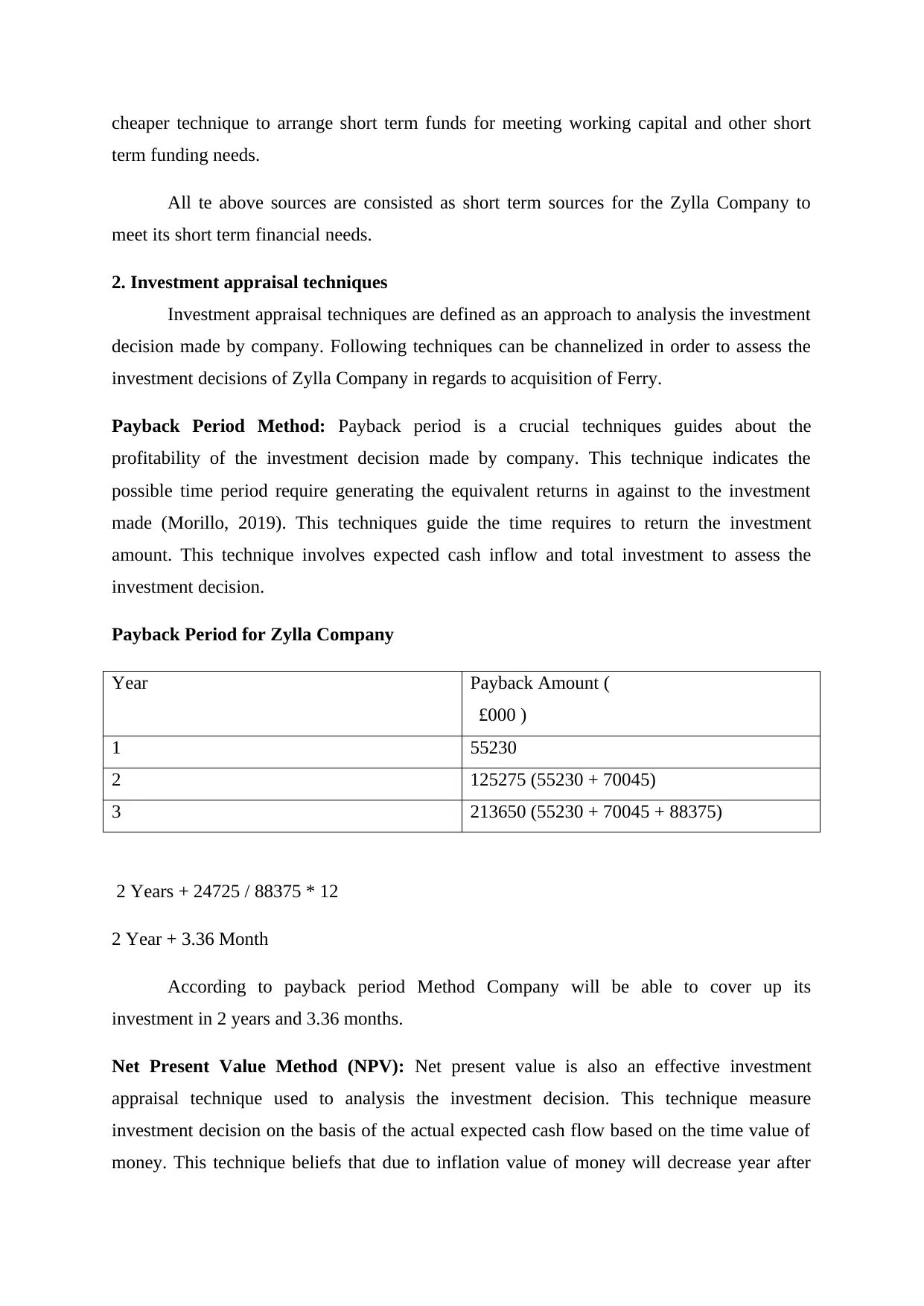
cheaper technique to arrange short term funds for meeting working capital and other short
term funding needs.
All te above sources are consisted as short term sources for the Zylla Company to
meet its short term financial needs.
2. Investment appraisal techniques
Investment appraisal techniques are defined as an approach to analysis the investment
decision made by company. Following techniques can be channelized in order to assess the
investment decisions of Zylla Company in regards to acquisition of Ferry.
Payback Period Method: Payback period is a crucial techniques guides about the
profitability of the investment decision made by company. This technique indicates the
possible time period require generating the equivalent returns in against to the investment
made (Morillo, 2019). This techniques guide the time requires to return the investment
amount. This technique involves expected cash inflow and total investment to assess the
investment decision.
Payback Period for Zylla Company
Year Payback Amount (
£000 )
1 55230
2 125275 (55230 + 70045)
3 213650 (55230 + 70045 + 88375)
2 Years + 24725 / 88375 * 12
2 Year + 3.36 Month
According to payback period Method Company will be able to cover up its
investment in 2 years and 3.36 months.
Net Present Value Method (NPV): Net present value is also an effective investment
appraisal technique used to analysis the investment decision. This technique measure
investment decision on the basis of the actual expected cash flow based on the time value of
money. This technique beliefs that due to inflation value of money will decrease year after
term funding needs.
All te above sources are consisted as short term sources for the Zylla Company to
meet its short term financial needs.
2. Investment appraisal techniques
Investment appraisal techniques are defined as an approach to analysis the investment
decision made by company. Following techniques can be channelized in order to assess the
investment decisions of Zylla Company in regards to acquisition of Ferry.
Payback Period Method: Payback period is a crucial techniques guides about the
profitability of the investment decision made by company. This technique indicates the
possible time period require generating the equivalent returns in against to the investment
made (Morillo, 2019). This techniques guide the time requires to return the investment
amount. This technique involves expected cash inflow and total investment to assess the
investment decision.
Payback Period for Zylla Company
Year Payback Amount (
£000 )
1 55230
2 125275 (55230 + 70045)
3 213650 (55230 + 70045 + 88375)
2 Years + 24725 / 88375 * 12
2 Year + 3.36 Month
According to payback period Method Company will be able to cover up its
investment in 2 years and 3.36 months.
Net Present Value Method (NPV): Net present value is also an effective investment
appraisal technique used to analysis the investment decision. This technique measure
investment decision on the basis of the actual expected cash flow based on the time value of
money. This technique beliefs that due to inflation value of money will decrease year after

year (Nathania and Putranto, 2018). Company must analyse the investment decision on the
basis of the actual cash flow generated in future after considering time value of money. This
technique analysis the investment decision based on the actual expected future cash flow.
This technique involves net present value to be positive, equal or negative. This technique
analysis that if the total expected present cash inflow is more than the cash outflow then the
investment decision is profitable in favour to the Zylla Company.
Year Future Cash Inflow
(£000)
NPV Value of
Money
Present Value of
Future Cash
Inflow
(£000 )
1 55230 .971 53628
2 70045 .943 66052
3 88375 .915 80863
4 79870 .888 70924
5 57555 .863 49670
Total Present Value of Cash Inflow (£000) = NPV as per expected cash inflow + NPV
value of sales of demolished Ferry at the end of 5th year
= 321137 + 38835 (45000 * .863)
= 359972
NPV (£000) = Total present value of cash inflow – Invvestment Amount
= 359972 – 150000
= 209972
As the investment is generating positive NPV value of cash inflow the investment
decision is profitable for the Zylla Company.
CONCLUSION
Report has concluded funding sources like bank finance, public holding and financial
institutions for the Zylla Company to meet its long term needs. In order to meet the short term
needs company can use overdraft agreement, account receivable financing and customer
basis of the actual cash flow generated in future after considering time value of money. This
technique analysis the investment decision based on the actual expected future cash flow.
This technique involves net present value to be positive, equal or negative. This technique
analysis that if the total expected present cash inflow is more than the cash outflow then the
investment decision is profitable in favour to the Zylla Company.
Year Future Cash Inflow
(£000)
NPV Value of
Money
Present Value of
Future Cash
Inflow
(£000 )
1 55230 .971 53628
2 70045 .943 66052
3 88375 .915 80863
4 79870 .888 70924
5 57555 .863 49670
Total Present Value of Cash Inflow (£000) = NPV as per expected cash inflow + NPV
value of sales of demolished Ferry at the end of 5th year
= 321137 + 38835 (45000 * .863)
= 359972
NPV (£000) = Total present value of cash inflow – Invvestment Amount
= 359972 – 150000
= 209972
As the investment is generating positive NPV value of cash inflow the investment
decision is profitable for the Zylla Company.
CONCLUSION
Report has concluded funding sources like bank finance, public holding and financial
institutions for the Zylla Company to meet its long term needs. In order to meet the short term
needs company can use overdraft agreement, account receivable financing and customer
⊘ This is a preview!⊘
Do you want full access?
Subscribe today to unlock all pages.

Trusted by 1+ million students worldwide
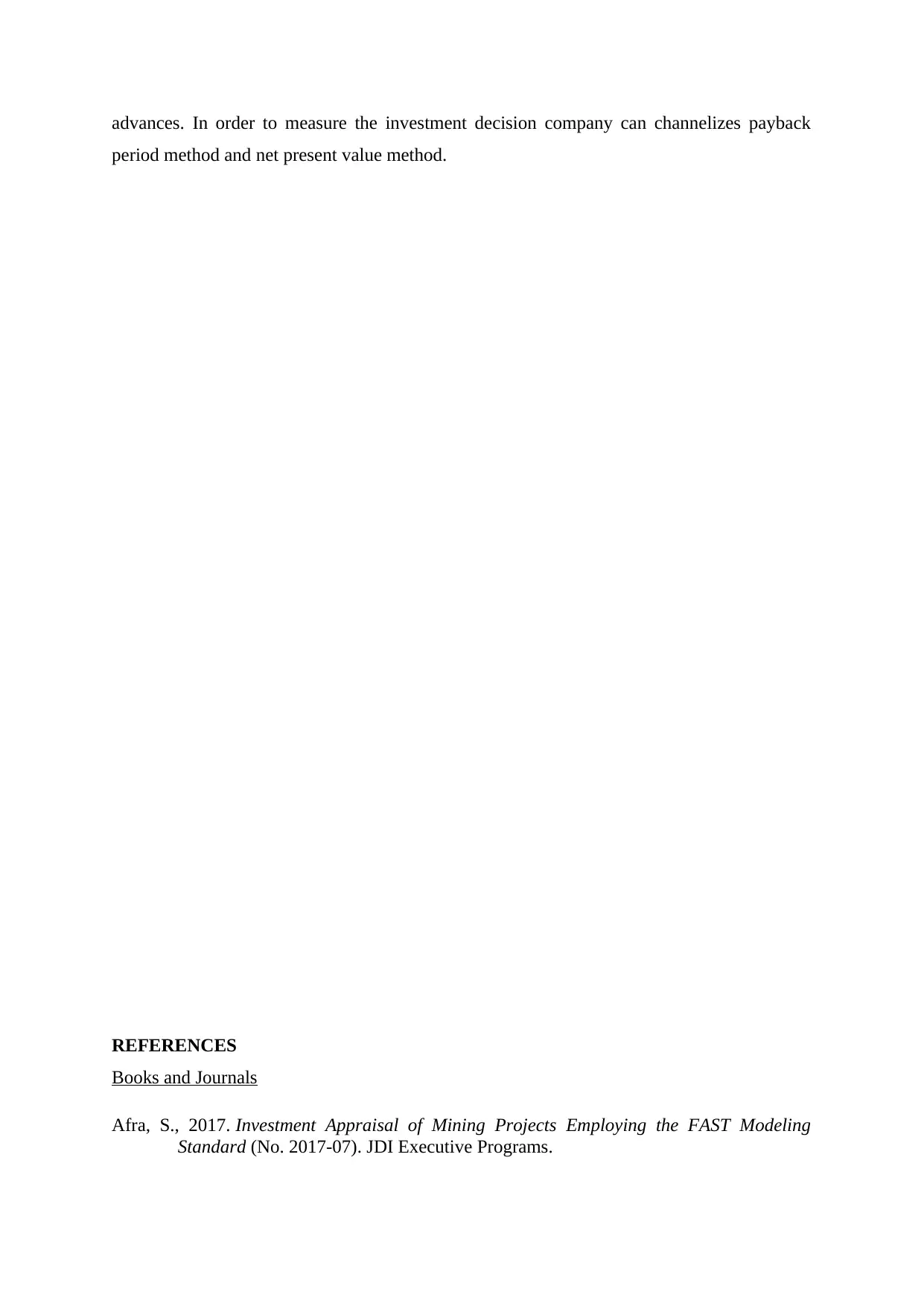
advances. In order to measure the investment decision company can channelizes payback
period method and net present value method.
REFERENCES
Books and Journals
Afra, S., 2017. Investment Appraisal of Mining Projects Employing the FAST Modeling
Standard (No. 2017-07). JDI Executive Programs.
period method and net present value method.
REFERENCES
Books and Journals
Afra, S., 2017. Investment Appraisal of Mining Projects Employing the FAST Modeling
Standard (No. 2017-07). JDI Executive Programs.
Paraphrase This Document
Need a fresh take? Get an instant paraphrase of this document with our AI Paraphraser
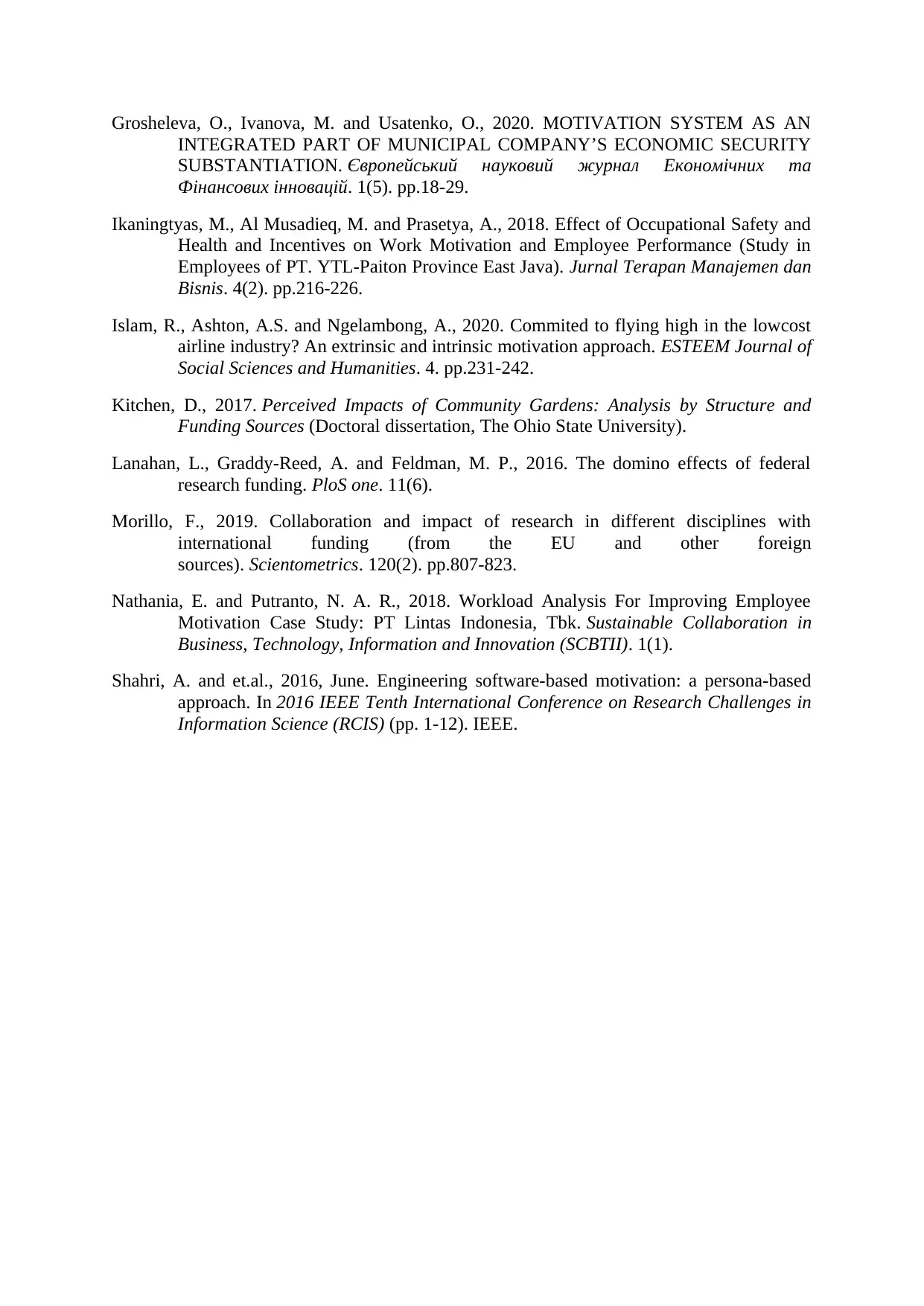
Grosheleva, O., Ivanova, M. and Usatenko, O., 2020. MOTIVATION SYSTEM AS AN
INTEGRATED PART OF MUNICIPAL COMPANY’S ECONOMIC SECURITY
SUBSTANTIATION. Європейський науковий журнал Економічних та
Фінансових інновацій. 1(5). pp.18-29.
Ikaningtyas, M., Al Musadieq, M. and Prasetya, A., 2018. Effect of Occupational Safety and
Health and Incentives on Work Motivation and Employee Performance (Study in
Employees of PT. YTL-Paiton Province East Java). Jurnal Terapan Manajemen dan
Bisnis. 4(2). pp.216-226.
Islam, R., Ashton, A.S. and Ngelambong, A., 2020. Commited to flying high in the lowcost
airline industry? An extrinsic and intrinsic motivation approach. ESTEEM Journal of
Social Sciences and Humanities. 4. pp.231-242.
Kitchen, D., 2017. Perceived Impacts of Community Gardens: Analysis by Structure and
Funding Sources (Doctoral dissertation, The Ohio State University).
Lanahan, L., Graddy-Reed, A. and Feldman, M. P., 2016. The domino effects of federal
research funding. PloS one. 11(6).
Morillo, F., 2019. Collaboration and impact of research in different disciplines with
international funding (from the EU and other foreign
sources). Scientometrics. 120(2). pp.807-823.
Nathania, E. and Putranto, N. A. R., 2018. Workload Analysis For Improving Employee
Motivation Case Study: PT Lintas Indonesia, Tbk. Sustainable Collaboration in
Business, Technology, Information and Innovation (SCBTII). 1(1).
Shahri, A. and et.al., 2016, June. Engineering software-based motivation: a persona-based
approach. In 2016 IEEE Tenth International Conference on Research Challenges in
Information Science (RCIS) (pp. 1-12). IEEE.
INTEGRATED PART OF MUNICIPAL COMPANY’S ECONOMIC SECURITY
SUBSTANTIATION. Європейський науковий журнал Економічних та
Фінансових інновацій. 1(5). pp.18-29.
Ikaningtyas, M., Al Musadieq, M. and Prasetya, A., 2018. Effect of Occupational Safety and
Health and Incentives on Work Motivation and Employee Performance (Study in
Employees of PT. YTL-Paiton Province East Java). Jurnal Terapan Manajemen dan
Bisnis. 4(2). pp.216-226.
Islam, R., Ashton, A.S. and Ngelambong, A., 2020. Commited to flying high in the lowcost
airline industry? An extrinsic and intrinsic motivation approach. ESTEEM Journal of
Social Sciences and Humanities. 4. pp.231-242.
Kitchen, D., 2017. Perceived Impacts of Community Gardens: Analysis by Structure and
Funding Sources (Doctoral dissertation, The Ohio State University).
Lanahan, L., Graddy-Reed, A. and Feldman, M. P., 2016. The domino effects of federal
research funding. PloS one. 11(6).
Morillo, F., 2019. Collaboration and impact of research in different disciplines with
international funding (from the EU and other foreign
sources). Scientometrics. 120(2). pp.807-823.
Nathania, E. and Putranto, N. A. R., 2018. Workload Analysis For Improving Employee
Motivation Case Study: PT Lintas Indonesia, Tbk. Sustainable Collaboration in
Business, Technology, Information and Innovation (SCBTII). 1(1).
Shahri, A. and et.al., 2016, June. Engineering software-based motivation: a persona-based
approach. In 2016 IEEE Tenth International Conference on Research Challenges in
Information Science (RCIS) (pp. 1-12). IEEE.
1 out of 11
Related Documents
Your All-in-One AI-Powered Toolkit for Academic Success.
+13062052269
info@desklib.com
Available 24*7 on WhatsApp / Email
![[object Object]](/_next/static/media/star-bottom.7253800d.svg)
Unlock your academic potential
Copyright © 2020–2025 A2Z Services. All Rights Reserved. Developed and managed by ZUCOL.


